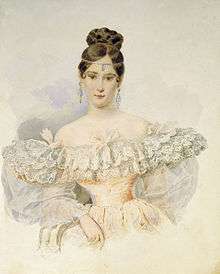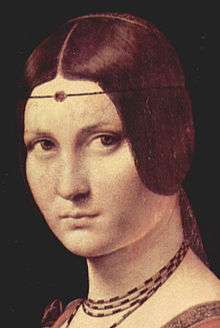Ferronnière
A ferronnière is a style of headband that encircles the wearer's forehead, usually with a small jewel suspended in the centre.[1] The original form of the headband was worn in late fifteenth-century Italy, and was rechristened a ferronnière at the time of its revival in the second quarter of the nineteenth century for both day and (more frequently) formal and evening wear.[2][3]


Etymology
The term ferronnière for describing such headbands was probably coined in the early nineteenth century. Merriam-Webster date the earliest use of the term to 1831,[4] and the Oxford English Dictionary notes that their record of the earliest usage of the term is located in a mid-19th-century publication called World of Fashion.[5] Some sources suggest that the term was contemporary to the 1490s.[6][7][8]
The ferronnière is often said to be named after a 1490s portrait attributed to the school of Leonardo da Vinci, the La belle ferronnière, where the sitter wears such an ornament.[2][3][9][10] However, this painting's title was assigned in the 18th century,[11] well after it was painted, under the erroneous assumption that it portrayed Madame Le Féron, a reputed mistress of Francis I of France; or another mistress who was allegedly an iron merchant's wife.[9][10] The literal translation of ferronnière in English is "ironmonger."[10] In their catalogue, the Louvre suggest that La belle ferronnière was so-called because of her forehead ornament, a theory that is supported by other scholars,[11][12] but other sources conclude that the ornament was named after the painting, due to the term's specific application apparently not existing prior to the 19th century.[5][9][10]
In fashion
The original ornament that later became called a ferronnière was popular in 15th-century Italy, where it could be made from metal or jewels.[6]
The nineteenth-century ferronnière was worn from the late 1820s to the early 1840s, when it was considered to enhance a high forehead, and by the 1850s, it had fallen out of fashion.[2] One contemporary source from 1831 describes the ferronnière as "a small plait of hair, adorned in the centre of the forehead by a large brilliant, from which depends another brilliant of the pear shape."[13] It has been described as one of the most widely worn examples of historicism in early Victorian fashion, worn as a tribute to the Renaissance alongside beaded belts called cordelières inspired by medieval clothing and hairstyles named after historic women such as Agnès Sorel and Blanche of Castile.[14] The ferronnière could be worn for either day or evening.[14] Alternative terms for similar ornaments were the bandelette and the tour de tête.[15][16]
References
- Lewandowski, Elizabeth J. (2011). The complete costume dictionary. Lanham, Md.: Scarecrow Press, Inc. p. 106. ISBN 9780810840041.
- Tetzeli von Rosador, Kurt (1984). "Gems and Jewellery in Victorian Fiction". The Yearbook of research in English and American literature. Tübingen: Narr. p. 289. ISBN 9783110098990. Retrieved 18 April 2013.
- Vookles, Laura (1986). The Jewelers' Eye: Nineteenth-century Jewelry in the Collection of Nancy and Gilbert Levine. Hudson River Museum. p. 102.
- "Definition of FERRONNIÈRE". www.merriam-webster.com. Merriam-Webster. Retrieved 1 March 2017.
- "Ferronière - definition of ferronière in English". Oxford Dictionaries. Oxford University Press. Retrieved 1 March 2017.
- Tortora, Phyllis G.; Eubank, Keith. Survey of Historic Costume. A&C Black. p. 192. ISBN 9781563678066.
- King, Ross (2012). Leonardo and the Last Supper. Bloomsbury Publishing. p. 293. ISBN 1408834278.
- Boussel, Patrice (1980). Leonardo da Vinci. Secaucus, N.J.: Chartwell Books. ISBN 1555211038.
- Viardot, Louis (1870). Wonders of Italian art. C. Scribner & Company. pp. 102.
- Crispino, Enrica. Leonardo. Ediz. inglese. Giunti Editore. p. 64. ISBN 9788809025486.
- de Silvestri, Paolo. Leonardo, or the universal genius. ATS Italia Editrice. p. 52. ISBN 9788875718732.
- "Portrait de femme, dit La Belle Ferronnière". cartelen.louvre.fr (in French). Louvre Museum Official Website. Retrieved 1 March 2017.
La confusion a été facilitée par le bijou, appelé ferronnière, que le modèle porte sur le front.
- The Atheneum, Volume 29. 1831. p. 295.
- Flower, Margaret (1973). Victorian Jewellery (2013 reprint). Read Books Ltd. ISBN 9781447483816.
- The Lady's Magazine and Museum. April 1833. p. 183.
- Metz, Nancy Aycock. The Companion to Martin Chuzzlewit. Helm Information Limited. p. 405. ISBN 9781873403846.
The allusion is to a tour de tete, also known as a ferroniere, an oval or circular brow-ornament held in place by a thin chain. This fashionable ornament - which was said to give the wearer a look of 'erudition' - was copied from a painting by Leonardo da Vinci...